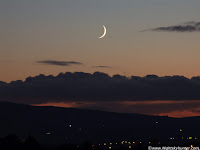For years it drove me mad. I guess I should say "loony." But I'm starting to get used to it, resigned to the fact that some cartoonists just don't know their astronomy. You've seen it: those crescent moons, whose "horns" are pointing the wrong way, like in the Mickey Mouse comic below.
 |
| Moon's wrong |
Think about it.....the moon gets its glow from the Sun. And if the Sun is lighting the Moon from the top, it would be up in the sky and it wouldn't be night!
Now, I have to contend with these astronomical errors when trying to relax with a good book. There I was, immersed in a historical novel about the 15th century English Plantagenets, when the author mentions the "waning moon rising off the horizon" at dusk.
 |
| Waning Crescent Rising at Sunrise |
Completely wrong. In that era of pitchblack nighttime skies, the Plantagenets themselves would be keenly aware how the Moon waxed and waned every four weeks—a waning Moon has its "horns" pointed up as it's rising in the East (as in the picture to the right). That means it's being lighted up from the Sun just below it. But, according to the novel, it's dusk, so the Sun has to be setting over on the other horizon in the west! It can't be rising in the east at the same time.
 |
| Waxing Crescent Setting at Sunset |
The author should have done their homework: a waning crescent Moon rises just before dawn, not at sunset. It is a waxing crescent Moon that is seen in the early evening. But it is not rising; it is setting in the west.
How sad that in just a few short centuries, we've lost touch with the rhythms of the heavens.


